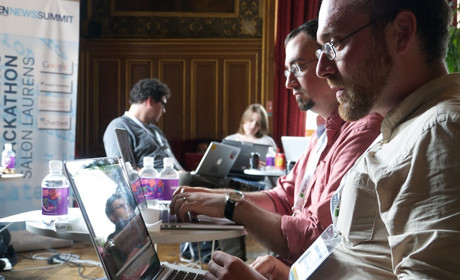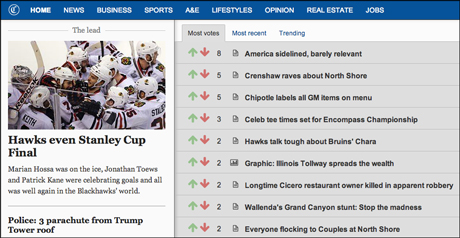
The Chicago Tribune team at work
Credit: Image by John ThompsonA team from Dutch title De Volkskrant has won a Google-supported international hackathon competition.
The trio were competing against 10 other teams from nine countries at the The Editors' Lab, held at the Global Editors Network summit in Paris last week.
The 11 teams, each of them winners of a regional heat, were given the brief to 'imagine your homepage based on social media interactions'.
The teams of three, each consisting of a journalist, a developer and a designer, spent two days coming up with a concept and prototyping.
Burt Herman, who founded Storify and Hacks/Hackers, presented the award late on Friday (21 June).
- De Volkskrant (Holland)
When presenting their winning concept as the summit, the team members explained that they were picking up on three trends: personalisation, social and mobile.
News sites are "not as personalised as Flipboard, not as social as Facebook or Twitter, and are not designed for mobile", they explained.
The redesigned news feed therefore allows readers to choose between seeing a summary and a short article. It also highlights stories that a reader's Facebook friends are reading, plus those read and shared by 'opinion makers', people on social who are influential.
- Libération (France)
The idea was "kind of a second homepage", displaying key topics both chosen by editors and as they are the most shared on social.
Readers could explore content by swiping through stories, reading short content on a smartphone, perhaps while travelling by bus, and reading the longer article "when they get home".
- Welad el Balad (Egypt)
News sites need unique content, explained director Fatemah Farag, and with Egypt in transition and in continuous protest with "90 million people in dissent", the team proposed a tool to pull the information together.
The concept they came up with was ‘The Daily Dissent’, which "tracks protest movements at hyperlocal level", displays information, such as travel disruptions, and provides a platform for citizen journalists.
The prototype used an open source tool from analytics platform Chartbeat, which was sponsoring the hackathon, to show the most shared information.
Farag also explained that the prototype was designed "with mobile in mind".
"The Daily Dissent is who we are online," she said. “This is the new face of Egypt."
- Zeit Online (Germany)
They decided to focus on the metric of engagement rather than on traffic, explaining that engagement would include factors such as time spent on an article, social shares and the number of comments, rather than simply looking at traffic and the number of hits.
They used various APIs to gather details, digging into the Zeit Online API, the Twitter API and the Chartbeat API, which shows tweets and shares for every article.
- Ask Media/Angry Katz (France)
The re-imagined site shows the editor's choices at the top with "the rest decided by an algorithm".
The redesigned site launches an application, with readers getting push notifications with updates.
- ORF (Austria)
Despite being the site for a broadcaster is does not show radio or TV content, the team explained, nor does it show social shares.
"But what if the social web was programming our homepage?" the team wondered, coming to the conclusion that it would need to be visual.
They therefore came up with a reorganised homepage, with ranking taken from the number of Facebook shares.
- Chicago Tribune (US)

Their thinking was "to try and find a better way for readers, editors and writers to get feedback".
"What about people who want to make their own news judgements?" they wondered. So they came up with the app which allows readers to vote stories up and down, much in the same way as users influence ranking on Reddit and Digg.
Content curated by editors is displayed on the left, content surfaced by readers voting it up is shown on the right.
The Chicago River layout is not proposed as a a replacement for homepage, but will instead complement it, allowing readers to choose which view they see.
From an editorial standpoint, "we wouldn’t have to change our workflow", the team explained.
- Clarín (Argentina)
They developed the navigation bar to display the most social stories.
They also created "a la carte" personalisation options, allowing registered users to show the favourite sections of the site.
- Al Masry Alyoum (Egypt)
They put the most recent content on one site, with a fixed part for advertising and opinion articles.
They came up with the idea of letting readers personalise content more and allowing them to filter the news they are most interested in.
- Mint (India)
They created a colour-coded mosaic based on real-time data which indicates to readers which stories are trending on the website.
The team said the solution would encourage readers to stay on the homepage for longer.
They said it would also help in monetisation. As the concept proposed is more engaging than the current site, the team believes the commercial team could charge advertisers more.
- Deutsche Welle (Germany)
"Redesigning the homepage is not enough", the team thought, and focused on "making a small target group really happy rather than lots of people more informed about the news".
As news sites often "trick" people into sharing their data, the team said, this app flips the question, allowing users to access data to help choose a profession. It is "fiercely on the side of the user", the team explained, "not on just giving away the user's data for marketing".
The app has questions about "what makes me rich?" and questions about "what makes me happy?".
The journalist in the Deutsche Welle team was data journalist Mirko Lorenz. The winning app that resulted in them winning the regional heat and being invited to the final in Paris was an interactive – called 'I pay this, you pay that' – which compares the cost of living worldwide. The prototype is worth a look and is at this link.
To see recordings of Google+ Hangouts in which the teams, see the Global Editors Network Google+ page.
Free daily newsletter
If you like our news and feature articles, you can sign up to receive our free daily (Mon-Fri) email newsletter (mobile friendly).
Related articles
- Audiences, AI and audio apps: five talking points from Perugia
- 40 essential newsletters every journalist should read
- What will determine the survival of local news?
- Immigration, EU, climate change: how 16 media outlets helped 16,200 readers with opposing views meet and talk
- New grassroots group aims to bridge the gap between tech and newsrooms









